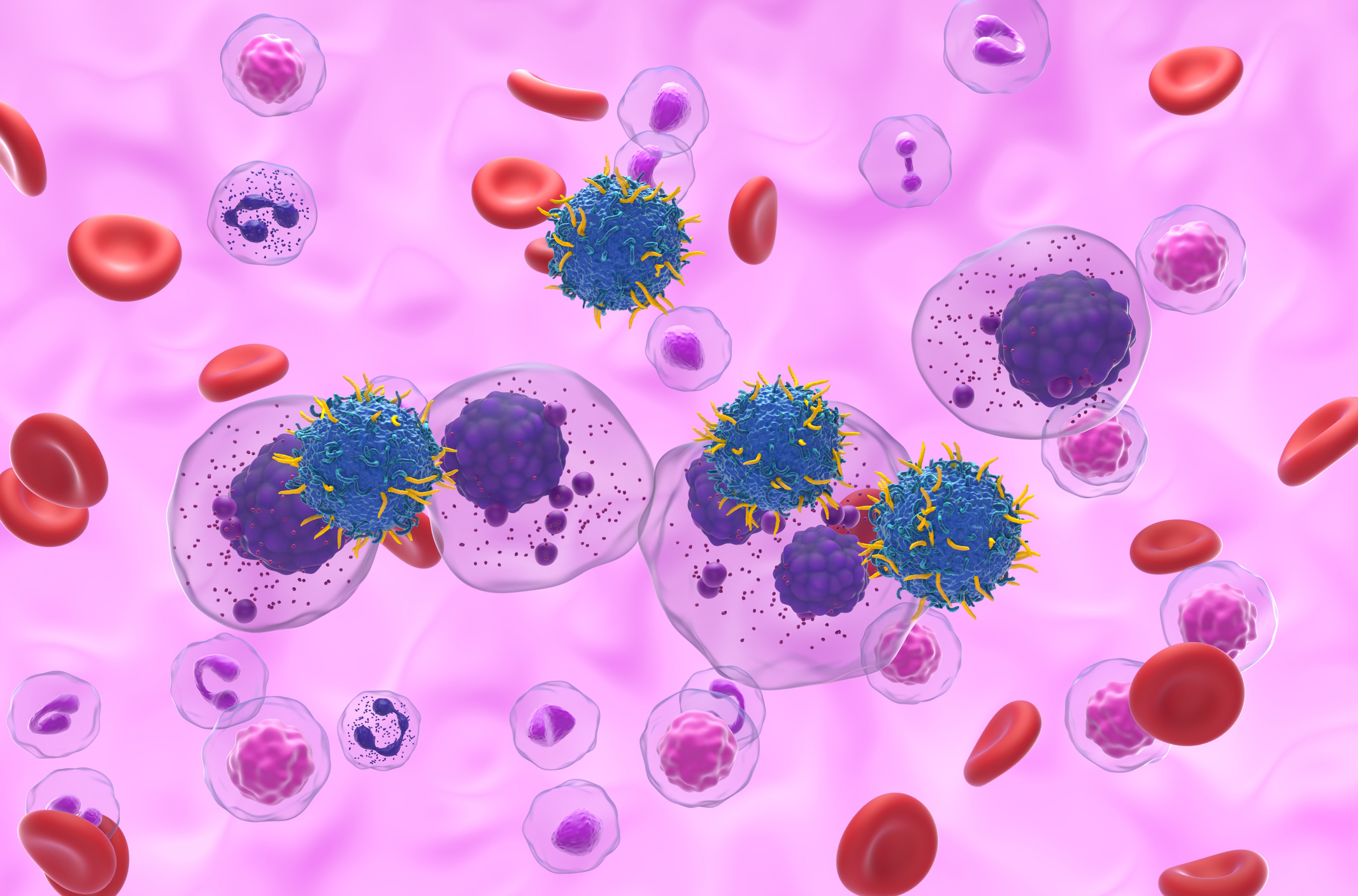Antiphospholipid syndrome (APS) is a life-threatening autoimmune disease of blood coagulation characterized by thrombophilia. In 2023, new international classification criteria were published for the first time since 2006. In view of the risk of recurrent thrombosis and vascular occlusion, long-term anticoagulation is generally the treatment of choice for confirmed APS.
The symptoms of antiphospholipid syndrome (APS) are multifaceted and are mainly characterized by recurrent microvascular, venous and arterial thrombi in various organs and tissues as well as pregnancy complications [1]. The tendency to thrombosis in APS can be explained by the procoagulatory effects of antibodies against phospholipids on thrombocytes and endothelial cells. Thrombosis is then caused by other triggering factors (e.g. infections, immobilization, pregnancy, local vascular processes, other thrombophilic risks). Antiphospholipid syndrome can occur as an independent clinical picture without any other autoimmune disease (primary APS), or as part of other autoimmune diseases (secondary APS). Common triggering underlying diseases or pre-existing conditions for APS include systemic lupus erythematosus (SLE) or rheumatoid arthritis, but also various malignant neoplasms and infections (e.g. HIV infection, hepatitis B, sepsis, malaria) [2].
The revised GSP criteria at a glance
The new classification criteria for APS supported by the American College of Rheumatology (ACR) and the European League Against Rheumatism (EULAR) were published in the journals Arthritis & Rheumatology and Annals of the Rheumatic Diseases in 2023 [3,4]. Dr. Doruk Erkan (MD, MPH), Dr. Medha Barbhaiya (MD, MPH) and Dr. Stephane Zuily (MD, MPH, PhD) served as co-principal investigators. On the one hand, the researchers aimed to achieve a high level of specificity and, on the other, to include symptoms of APS that had not previously been mapped. The entry criterion was defined as the presence of at least one positive antiphospholipid antibody (aPL) test within three years of the detection of an aPL-associated clinical criterion. In addition, there are various additively weighted criteria (range of points from 1-7 in each case).
“The experts identified six clinical and two laboratory diagnostic criteria, which were weighted accordingly,” explained Dr. med. Lorenzo Alberio, Chief Physician, Service et Laboratoire centrale d’Hématologie, CHUV, Lausanne [5]. A result is classified as APS in patients who achieve at least 3 points in each of the clinical and laboratory diagnostic areas. The criteria and their weighting are shown in Table 1 . In the case of persistence over 12 weeks, both lupus anticoagulant (LAC) and IgG antibodies against β2-glycoprotein-I or cardiolipin are included in the evaluation with at least 3 points, while IgM antibodies are only weighted with 1 point. While the limit of 3 is reached or exceeded for venous or arterial thrombotic events in the absence of additional risk factors, this does not apply to simultaneous relevant risk factors. This limit is also reached by valve vegetations in which there is confirmed microvascular involvement or in severe forms of placental insufficiency and pre-eclampsia. Two points are awarded for clinically diagnosed microangiopathy, valve thickening and thrombocytopenia (20,000-130,000), but only one point for premature births and miscarriages. In the validation cohort, the new APS criteria had a specificity of 99% vs. 86% and a sensitivity of 84% vs. 99% compared to the revised Sapporo classification criteria of 2006. In summary, the new ACR/EULAR classification criteria are based on a more modern understanding of antiphospholipid syndrome and meet high methodological quality standards [3,4].
Why the Sapporo criteria needed to be revised
Since the introduction of the Sapporo criteria, significant progress has been made in understanding APS, allowing better characterization of APL-associated non-thrombotic clinical manifestations, identification of the role of traditional thrombosis risk factors in aPL-positive individuals, and risk stratification by aPL profile [6,7]. The revised Sapporo criteria have been criticized for not including evidence-based definitions, such as aPL positivity, microvascular disease or pregnancy morbidity, resulting in a heterogeneous group of aPL-positive patients with different risk profiles being included in the research [7,8]. The present new classification criteria correspond to a more stringent methodology based on data-driven and expert-based approaches [9]. This will ensure high-quality, risk-stratified epidemiological and clinical studies in APS in the future, leading to improved patient care and better recommendations.
APS pathomechanisms: how a prothrombotic situation develops
Antiphospholipid antibodies (aPL) represent a heterogeneous group of autoantibodies directed against phospholipid-protein complexes. Lupus anticoagulants are a coagulant subgroup in which antibodies lead to a prolongation of phospholipid-dependent coagulation tests [10]. Antiphospholipid antibodies (aPL) can be detected in approximately one third of patients with SLE and the frequency of positive aPL detection is 5-20% in women with pregnancy complications, in patients after deep vein thrombosis, after a myocardial infarction or after a stroke at the age of <55 years [10,11]. Women are significantly more frequently affected than men; the ratio of women to men is 7:1 in secondary APS and 3.5:1 in primary APS [12]. Antiphospholipid antibodies bind to phospholipid-protein complexes on cell membranes, such as β-2 glycoprotein I (β-2-GPI) – a protein that itself binds to negatively charged molecules such as phospholipids, cardiolipin and phosphatidylserine and other phospholipids of activated endothelial cells and thrombocytes [13]. By inhibiting contact activation, it acts as a moderate inhibitor of coagulation activation [6]. If antiphospholipid antibodies bind to β-2-GPI, this results in the expression of tissue thromboplastin (tissue factor, TF) and adhesion molecules. In addition to inhibiting the expression of TFPI (tissue factor pathway inhibitor) , reduced protein C activity and complement activation were also detected. These mechanisms inactivate the antithrombotic surface of endothelial cells, resulting in a prothrombotic situation [10].
Congress: Allergy & Immunology Update
Literature:
- Röthlin A, Buser C: Livedo racemosa als Manifestation eines Antiphospholipid-Syndroms. Swiss Med Forum 2023; 23(10): 950–953.
- «Antiphospholipid-Syndrom», https://flexikon.doccheck.com, (last accessed 26.02.2024),
- Barbhaiya M, et al.: ACR/EULAR APS Classification Criteria Collaborators. The 2023 ACR/EULAR Antiphospholipid Syndrome Classification Criteria. Arthritis Rheumatol 2023; 75(10): 1687–1702.
- Barbhaiya M, et al.: ACR/EULAR APS Classification Criteria Collaborators. 2023 ACR/EULAR antiphospholipid syndrome classification criteria. Ann Rheum Dis 2023; 82(10): 1258–1270.
- «What’s new in antiphospholipid syndrome?», Dr. med. Lorenzo Alberio, Allergology and Immunology Update, Grindelwald, 27.01.2024
- Garcia D, Erkan D: Diagnosis and management of the antiphospholipid syndrome. NEJM 2018; 379: 1290.
- Sciascia S, et al: 16th International congress on antiphospholipid antibodies task force report on clinical manifestations of antiphospholipid syndrome. Lupus 2021; 30: 1314–1326.
- Erkan D, et al.: Antiphospholipid syndrome clinical research task force report. Lupus 2011; 20: 219–224.
- Johnson SR, et al.: Classification criteria in rheumatic diseases: a review of methodologic properties. Arthritis Rheum 2007;57: 1119–1133.
- Madlener K: Das Antiphospholipid-Syndrom. Eine interdisziplinäre Herausforderung. Akt Rheumatol 2018; 43: 456–462.
- Pengo V, et al.: Update of the guidelines for lupus anticoagulant detection. J Thromb Haemost 2009; 7: 1737–1740.
- Quehenberger P, Pabinger-Fasching I: Antiphospholipid-Syndrom. In: Pötzsch B, Madlener K, (Hrsg). Hämostaseologie. 2. Aufl. 2010: Springer; 404–407.
- Schössler W: Phospholipide und Phospholipid-bindende Proteine. In: Pötzsch B, Madlener K, (Hrsg). Hämostaseologie. 2. Aufl. 2010: Springer; 237–244.
- Vega-Ostertag M, et al.: Involvement of p38 MAPK in the up-regulation of tissue factor on endothelial cells by antiphos pholipid antibodies. Arthritis Rheum 2005; 52: 1545–1554.
- Liestol S, et al.: Decreased anticoagulant response to tissue factor pathway inhibitor type 1 in plasmas from patients with lupus anticoagulants. Br J Haematol 2007; 136: 131–137.
- Arachchillage DR, et al.: Anti-protein C antibodies are associated with resistance to endogenous protein C activation and a severe thrombotic phenotype in antiphospholipid syndrome. J Thromb Haemost 2014; 12: 1801–1809.
- Breen KA, et al.: Complement activation in patients with isolated antiphospholipid antibodies or primary Antiphospholipid syndrome. Thromb Haemost 2012; 107: 423–429
- Cosentino F, Grant PJ, Aboyans V, et al.: 2019 ESC guidelines on diabetes, pre-diabetes, and cardiovascular diseases developed in collaboration with the EASD. Eur Heart J 2020;41: 255–323.
HAUSARZT PRAXIS 2024; 19(3): 42–44 ( published on 20.3.24, ahead of print)















